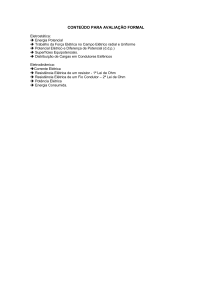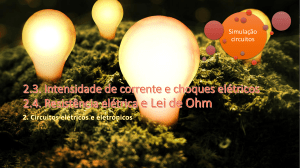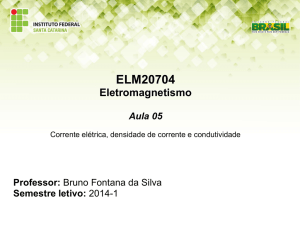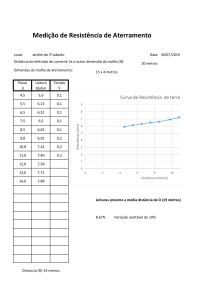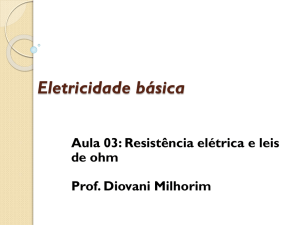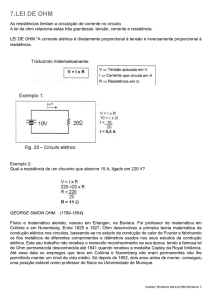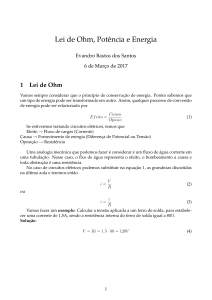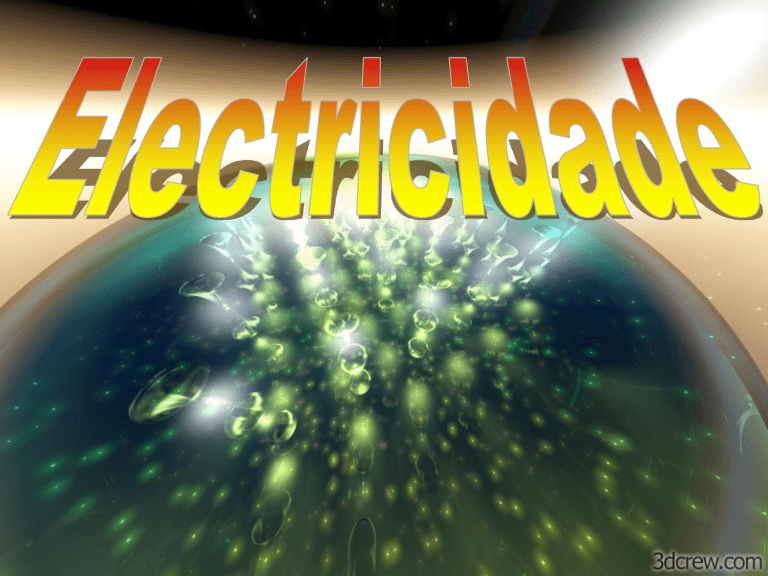
Lembram do elétron?
Este elemento é o responsável
da carga transportada e, portanto,
das propriedades elétricas do material.
[Q] = coulomb
Campo Elétrico
O CE é uma grandeza física.
Rodeia qualquer carga e estende-se até o infinito.
Q
Ek 2
r
Lembram dos arranjos atômicos?
Os átomos do cristal vao interferir (ou ajudar)
no movimento dos elétrons e, portanto,
também participarão das propriedades
elétricas do material.
http://physics.nad.ru/Physics/English/phon_tmp.htm
Cargas elétricas podem movimentar-se sob a ação de campos elétricos e magnéticos,
e em diversos ambientes. Vamos cuidar de distinguir bem cada um desses casos.
Inicialmente vamos tratar de elétrons movendo-se em resistores, em regime
estacionário, sob a ação de um campo elétrico provido por uma bateria
http://www.if.ufrgs.br/tex/fis142/mod06/m_s01.html
Define-se intensidade de corrente elétrica como a quantidade de
cargas que atravessa a seção reta de um condutor, por unidade
de tempo. Isto é,
Remember !
q
i
t
vol fluido
Vazão
t
A corrente elétrica por unidade de área transversal define o
módulo do vetor densidade de corrente J.
i
J
A
Do ponto de vista microscópico, há uma relação muito importante entre a
densidade de corrente e a velocidade de deriva.
Seja um segmento de condutor, L, como ilustrado na Figura. Suponha que
existam ‘n’ elétrons por unidade de volume; esta é a densidade de portadores
do material. Portanto, a densidade de cargas no condutor será ‘ne’, e a carga
total no segmento de condutor será
q = neAL
Um elétron percorrerá este segmento no intervalo de tempo
t = L/Vd
onde Vd é a velocidade de deriva. Da definição de corrente, obtém-se
i = q/t = neAVd
Da definição de densidade de corrente, obtém-se
J = neVd
A corrente é o fluxo da densidade de corrente!
http://www.slcc.edu/schools/hum_sci/physics/tutor/2220/current_resistance/
Current flow through a metal.
(Note: The electrons are colored differently to
make tracking easier.)
Current flow through a vacuum.
(Note: The electrons are colored differently to make
tracking easier.)
Voltagem
No mundo macroscópico…
A dependência V vs I….
15
10
5
0
0
1
2
3
Corrente
Voltagem
No mundo macroscópico…
15
É linear …?
10
5
0
0
1
2
3
Corrente
Voltagem
No mundo macroscópico…
Ou é cúbica …?
15
10
5
Y =0.4722+2.25236 X+0.62394 X
0
0
1
2
3
Corrente
2
Cómo diferenciar …?
Voltagem
15
10
5
0
0
1
2
3
Corrente
Voltagem
No mundo macroscópico…
15
10
5
Não Funciona….
0
0
1
2
3
Corrente
Voltagem
No mundo macroscópico…
15
B
Polynomial Fit of EXP1_B
Upper 95% Confidence Limit
Lower 95% Confidence Limit
10
Melhorou…
5
2
Y =0.56151+2.07488 X+0.68294 X
0
0
1
2
3
Corrente
Voltagem
Outras barras (incertezas maiores)…
Mudam a situação
drásticamente
15
10
5
0
0
1
2
3
Corrente
Voltagem
Agora temos um ajuste que passa por
todos os ‘pontos experimentais’
B
Linear Fit of EXP2_B
15
10
5
Y = 3.70193 * X
0
0
1
2
3
Corrente
Voltagem
Porém, não exagerar…
B
Polynomial Fit of EXP2_B
15
10
5
3
V=RI
0
0
1
2
3
Corrente
Voltagem
Porém, não exagerar…
B
Polynomial Fit of EXP2_B
15
10
5
4
V=RI
0
0
1
2
3
Corrente
Voltagem
Porém, não exagerar…
B
Polynomial Fit of EXP2_B
15
10
5
4
V=RI
0
0
1
2
3
Corrente
Voltagem
Posso fazer perfeito ?…
B
Polynomial Fit of EXP2_B
15
10
5
6
V=RI
0
0
1
2
3
Corrente
Voltagem
Posso fazer perfeito ?…
B
###
15
10
5
6
V=RI
0
0
1
2
3
Corrente
É uma relação Linear
V ~ I
V=R I
[R] = volt/ampere = OHM
É uma relação Linear
V
15
10
5
tg = R
0
-3
-2
-1
0
1
2
-5
-10
-15
3
I
tg = cat op/cat adj = V/I
R = V/I
UNIDADES
Queremos achar as unidades de I e R:
I = q /t
I=
R=
r=
Coulomb
segundo
= Ampere
Volt
Ampere
Ohm m2
m
= OHM
[ r ] = ohm.m
Grandeza
SI (kg, m, s)
Simbolo
Corrente
Ampere
I
Resistência
Ohm
Ω
Resistividade
Ohm.metro (Ω.m)
ρ
condutividade
Ohm.metro recíproca
(Ω.m)-1
UNIDADES
L
R~L
R ~ 1/A
A
L
R
A
L
Rr
A
2
ohm.m
[r ]
ohm.m
m
L1
L1 = L3=L2/2
d1
L2
d1 = d2 = 2d3
d2
rR
d2
6L
6L
Rr
2
d
L3
d3
2
2
2
1
R1 L1 d
R2 L2 d
R1 1
R2 2
R1 1
R3 4
O ‘feeling’ da resistividade
Resistivity and Temperature Coefficient at 20 C
Material
Resistivity r
(ohm m)
Silver
Copper
Aluminum
Tungsten
Iron
Platinum
Manganin
Lead
Mercury
1.59
1.68
2.65
5.6
9.71
10.6
48.2
22
98
x10-8
x10-8
x10-8
x10-8
x10-8
x10-8
x10-8
x10-8
x10-8
Coefficient Conductivity
per degree C
x 107 /Wm
.0061
.0068
.00429
.0045
.00651
.003927
.000002
...
.0009
6.29
5.95
3.77
1.79
1.03
0.943
0.207
0.45
0.10
Material
Resistivity r
(ohm m)
Nichrome
(Ni,Fe,Cr alloy)
100
x10-8
.0004
49
x10-8
...
3-60
x10-5
-.0005
1-500
0.1-60
1-10000
x10-3
...
x109
-.05
-.07
...
7.5
x1017
...
1-100
x1013
...
Constantan
Carbon*
(graphite)
Germanium*
Silicon*
Glass
Quartz
(fused)
Hard rubber
Coefficient
per degree C
Resistivity vs. Purity
ASTM International
"The method of preparing Type I reagent water may add organic contaminants to the water by contact with the ion-exchange materials." –
Standard Specification for Reagent Water (D1193), Annual Book of ASTM Standards, American Society of Testing Materials, 11.01(1), 2001
High-Q
". . . deionized, 18 megohm-cm water, often referred to as ultrapure water, is likely to be so impure that it smells – Reagent Water, HighQ position Paper, High-Q, Inc., 2000
Millipore
"Measuring Resistivity Is Not Enough – Water at the theoretically pure limit of 18.2 megohms-cm may still contain high concentrations of neutral
organic contaminants which may adversely affect your analytical methods and cause analyses to fail. Most water purification systems exhaust their
capacity to remove dissolved organics before they lose their capacity to remove ions." – A10 Brochure, Millipore, Corporation 1996
"What You Can't See Can Hurt You! – When it comes to ultrapure water, what you can't see can often hurt you. Your system's resistivity meter
may indicate that your product water is at the theoretically "pure" limit of 18.2 megohm-cm, but don't be fooled! In spite of high resistivity levels, your
water can still contain high concentrations of organic contaminants which cannot be detected by resistivity measurements alone." – Waterline,
Millipore, Corporation 1995
"Millipore' Corp's Jon DiVincenzo explains that simply dissolving sugar in 18 megohm-cm water can raise the TOC values to 1000 parts per
billion (ppb) without reducing the specific resistance of the water." – Brush M. Water, water, everywhere. The Scientist 1998; 12(12):18-20.
Intel
“We all ‘know’ that a good high-purity water system can meet 18+ megohm-cm, 1 to 2 ppb of TOC and silica, very low oxygen levels, and less
than 10 particles per liter (p/L) at 0.05 micron optical size. The agony is that most of these measurements are completely in error. Not only are
we not getting real analytical data, we don't know that we are not getting real analytical data. Everything looks OK, and the instruments are
behaving like they always have - so there is nothing to indicate that the numbers are entirely bogus.”– Carr G. Instruments - Evaluating
the limitations of current technologies and improvements in future analytical methods. Ultrapure Water 2001; 18(2):24-32)
Circuitos Elétricos
A nine volt battery supplies power to a cordless curling iron with a
resistance of 18 ohms. How much current is flowing through the curling
iron?
Circuitos Elétricos
Solution:
1.) Since V(Voltage) and R(Resistance) are known, solve for I(Current) by dividing
both sides of the equation by R.
2.) The R's on the right hand side of the equation cancel.
3.) I is then left in terms of V and R.
4.) Substitute in the values for V(Voltage) and R(Resistance).
5.) Solve for I(Current).
Circuitos Elétricos
Problema #1
A 110 volt wall outlet supplies power to a strobe light with a resistance of 2200
ohms. How much current is flowing through the strobe light?
Choose your answer below
1.0.5 amps
2.2.0 amps
3.0.05 amps
4.1.0 amps
=110/2200 = 1/20
Circuito Série
A corrente é a mesma para todos os elementos do
circuito:
A queda de tensão ao longo do circuito também é aditiva
Como V = IR
Mas a Lei de Ohm vale para o circuito completo
Igualando 3 e 4
Como todas as I são iguais
Circuito Paralelo
Req
Circuito Geral
I1 ?, I2 ?, V3 ?, etc… ?,
Resistive
dissipation !!
Medida de Resistencia – 4 Pontas
1
R = V12/I12
R
2
V34= V12 + 2 v
I12 = i
V34= iR + 2 r i
v=ri
v=ri
3
i
4
i
A
V 2ri
R
i
Medida de Resistencia – 4 Pontas
R = V12/i
RV >>> RA
V
iV=0
i
R
L
1
i
2
i
A
i
TRANSPORT
i
V
x
d
L
IxV
Sample 4
Sample 7
R0 = 4,49 KW
0,0
-0,8
R0 = 1,25 KW
-800
-400
0
V (mV)
400
800
Magnetic Materials Laboratory - USP
I (mA)
0,8
L
i
TRANSPORT
i
V
x
d
L
L
6
10
6
1
0
4x10
10
7
5
5
10
1
1
0
3x10
4
2
10
R (W)
6
3
3
4
10
1
0
2
2x10
5
10
4
6
6
1
3
10
7
1
0
1x10
8
6
100 150 200 250 300
T (K)
9
2
Magnetic Materials Laboratory - USP
6
1
0
0
100
150
200
250
300
4
6
8
1
0
1
2
1
T (K) 1
0
0
0
/
T
(
K
)
i
TRANSPORT
i
V
x
d
L
4
3
R(W)
1
0
U
k BT
r (T ) r0 exp
1
0
2
TV
1
1
0
Magnetic Materials Laboratory - USP
1
0
L
3
6
9
1
2
1
0
0
0
/
T
(
K
)
i
TRANSPORT
x
Rr
Ld
i
V
x
1
R
d
d
L
L
9
R(d) = R0 + r (1/d)
RR (k
W)
(kW)
r = 1.69x10 Wm
6
4
3
2
MgAl2O4
Al2O3
MgO
0
0
00
8
100
16
200
-1
Thickness
1000/d
(nm )(nm)
30024
400
Magnetic Materials Laboratory - USP
-3
6
Medição de RESISTIVIdade
na Industria
Medição de RESISTIVIdade
na Industria
Low Current/High Resistance Measurement Products
Document Actions
•
Model 65 High-Resistivity Measurement Package, including Model 6517A Electrometer/High-Resistance Meter,
Model 6524 High-Resistance Measurement Software and Model 8009 Resistivity Test Fixture
MEGGER
http://www.repaircalibration.com/avo-ground-resistance-testers.html
IBM
http://www.research.ibm.com/research/gmr.html
Medição de Resistividade
no Laboratório
Laboratório #3
Laboratório #3
Objetivos:
• Introduzir o conceito de resistencia dos materiais.
• Principio de funcionamento dos multimetros.
• Medir a resistividade de diversos materiais. Testar a Lei de
Ohm.
• Montar Circuitos Eletricos adequados para cada situação.
• Obter as incertezas e propagar os desvios.
Laboratório
#3
Laboratório
#3
http://www.if.ufrgs.br/tex/fis142/mod06/m_s04.html
Laboratório
#3
• Intro
• Material
• Tipo de medidas
• Erros envolvidos (instrumentais)
• Que foi medido
• Estratégias para medir
• Dificuldades
• resultados
• Propag. de Erros.
•Conclusões


